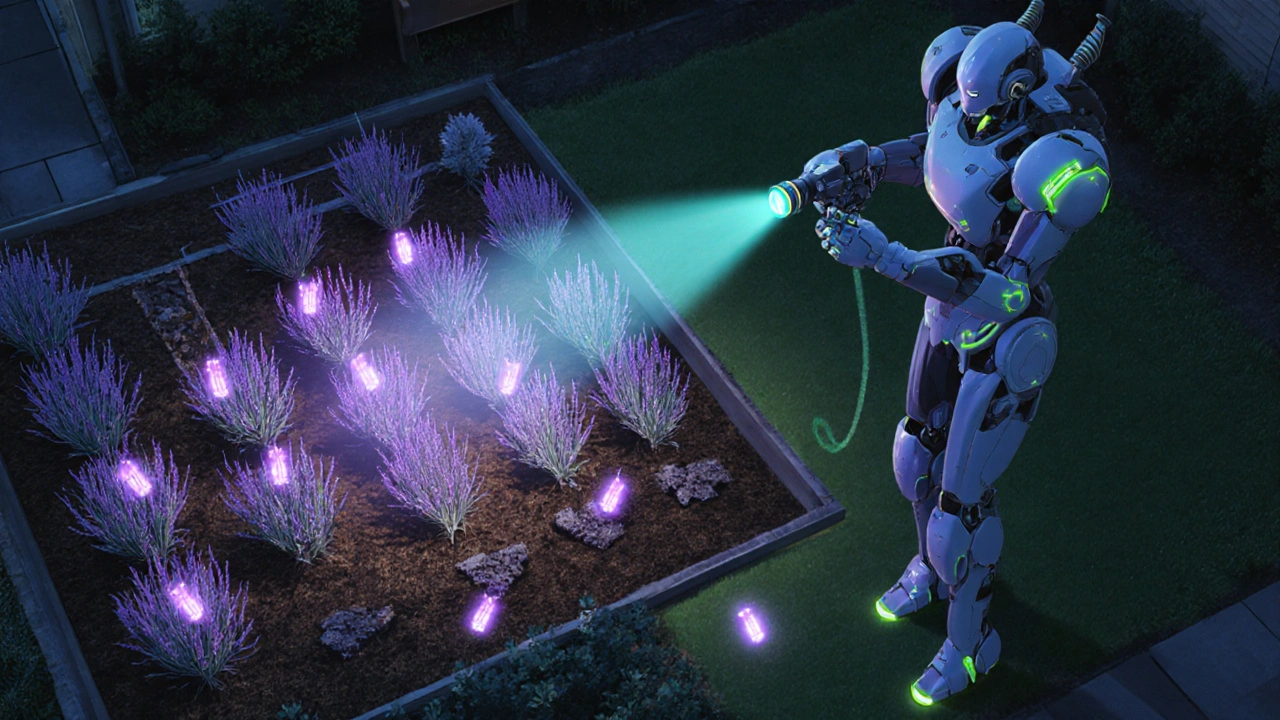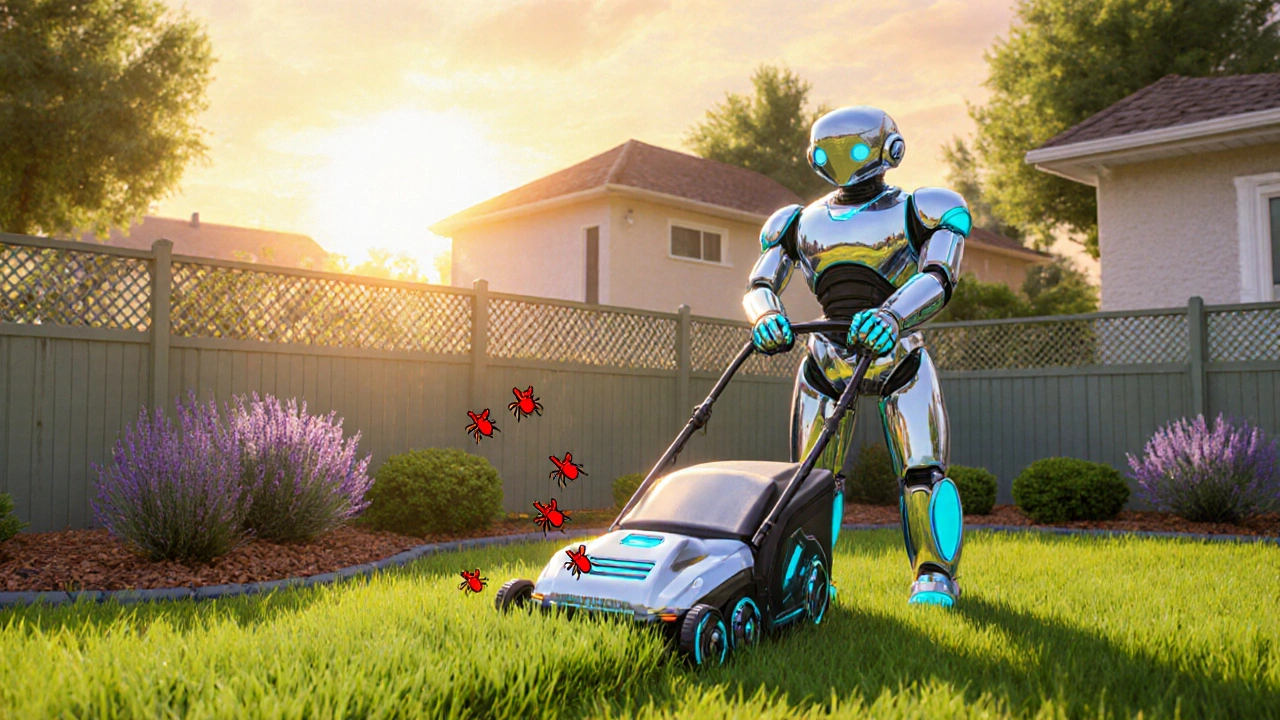Tick Risk Assessment Tool
Answer these questions to assess your backyard's tick risk level. Based on factors like grass height, shade, and maintenance habits.
Tick Risk Assessment
Overall Risk Level
Key Risk Factors
- Grass Height: 0
- Shaded Areas: 0
- Leaf Litter: 0
- Animal Pathways: 0
- Mowing Frequency: 0
Recommended Actions
Quick Takeaways
- Trim grass and remove leaf litter regularly to eliminate tick habitats.
- Use deer‑exclusion fencing or plant barrier species to reduce host access.
- Apply targeted, low‑toxicity treatments like permethrin or tick tubes during peak season.
- Inspect yourself, kids, and pets after every outdoor visit and shower promptly.
- Follow a seasonal maintenance calendar to stay ahead of tick activity.
Understanding Ticks and Tick‑Borne Illnesses
Tick is a small arachnid that feeds on the blood of mammals, birds, and reptiles. A tick can transmit bacteria, viruses, and parasites, the most notorious being the bacterium that causes Lyme disease. When you hear about "tick fever," it often refers to the flu‑like symptoms that follow a bite from an infected tick. Knowing the life cycle-egg, larva, nymph, adult-helps you target the weak points. Nymphs, about the size of a poppy seed, are the hardest to spot and most responsible for disease transmission.
Lyme disease is a tick‑borne illness caused by Borrelia burgdorferi. Early symptoms include a bullseye rash, fever, headache, and fatigue. If untreated, it can affect the joints, heart, and nervous system. Preventing tick bites is the most effective front‑line defence against Lyme disease.
Step 1: Assess Your Backyard for Tick Hotspots
Walk the perimeter of your garden and note any shaded, moist areas where leaf litter accumulates. These micro‑habitats are prime real‑estate for ticks.
- Check the edges of lawns, especially where they meet wooded sections.
- Inspect compost piles, flower beds, and garden borders for tall grass or brush.
- Identify animal pathways-deer, rodents, and even birds can ferry ticks into your yard.
Document findings on a simple sketch; it will guide your next actions.
Step 2: Choose a Tick‑Resistant Landscape Design
Landscape choices can either invite or deter ticks. Aim for a "hard‑scape" approach where you replace dense vegetation with easy‑to‑maintain surfaces.
- Grass Management: Keep lawn grass no higher than 2‑3 inches. Use a mower with a mulching blade to return clippings to the soil, reducing leaf litter.
- Mulch Selection: Opt for coarse bark or rubber mulch instead of fine wood chips, which hold moisture.
- Barrier Plants: Plant Lavandula angustifolia (lavender) or Rosmarinus officinalis (rosemary) along walkways; their strong scents repel both ticks and small mammals.
Creating sun‑exposed zones discourages the humid micro‑climate ticks love.

Step 3: Implement Physical Barriers to Limit Host Access
Deer and rodents are the main hosts that bring ticks into residential yards. Reducing their presence cuts the supply chain.
Deer are large mammals that frequently traverse suburban gardens, especially during autumn mating season. Installing a 8‑foot high fence with a tight mesh (no larger than 4 inches) can block most deer movement.
For rodents, consider the following:
- Seal gaps under sheds and decks.
- Use metal flashing around the base of trees.
- Place Tick tubes filled with permethrin‑treated cotton nesting material that rodents collect and bring back to their burrows. This method targets the tick’s hidden stage inside rodent nests.
Step 4: Apply Targeted, Low‑Toxicity Treatments
When cultural changes aren’t enough, supplement with chemical or biological controls.
| Method | Effectiveness | Safety | Cost | Application Frequency |
|---|---|---|---|---|
| Permethrin spray (synthetic pyrethroid) | High | Low for humans when dried; toxic to aquatic life | $$ | Every 2‑3 weeks during peak season |
| Tick tubes (permethrin‑treated cotton) | Medium‑High | Very safe for pets and humans | $$ | Replace twice a year (spring & fall) |
| Biological control (Entomopathogenic fungi) | Low‑Medium | Eco‑friendly, non‑toxic | $ | Monthly during damp periods |
| Manual removal (hand‑picking) | Low | 100% safe | Free | Daily during high activity |
For most UK homeowners, a combined approach-permethrin perimeter spray plus tick tubes-offers the best balance of efficacy and safety.
If you prefer an organic route, look into Entomopathogenic fungi such as Metarhizium brunneum that infect and kill ticks without harming beneficial insects. Apply according to label directions; results are slower but environmentally benign.
Step 5: Protect Yourself, Children, and Pets
Even a perfectly managed yard can’t guarantee zero ticks. Personal protection adds a crucial safety net.
- Clothing: Wear long sleeves, high cuffs, and light‑colored gear so ticks are easier to spot.
- Repellents: Choose EPA‑registered products containing 30‑40% DEET, picaridin, or IR3535. For pets, look for Permethrin formulated for collars or spot‑on treatments, safe for dogs but toxic to cats.
- Post‑visit shower: Wash off any unattached ticks within 30 minutes; the water stream helps dislodge them.
- Tick checks: Run your hands over the scalp, behind ears, underarms, and groin. Use a fine‑tooth comb for kids’ hair.

Step 6: Seasonal Maintenance Calendar
Consistency beats occasional effort. Mark these dates on your family calendar.
| Month | Action |
|---|---|
| March | Mow early‑season grass, apply first permethrin perimeter spray. |
| April | Install or replace tick tubes, check fence integrity. |
| May | Mid‑season spray, prune shrubs to improve sunlight. |
| June-July | Weekly visual inspections, re‑apply spot‑on pet treatments. |
| August | Second round of tick tubes, evaluate mulch depth. |
| September | Final deep mowing, reduce leaf litter before autumn. |
| October-November | Store equipment, perform one last fence check. |
Stick to the plan and you’ll notice fewer ticks even before the next summer arrives.
Common Mistakes to Avoid
- Relying solely on one method-ticks quickly adapt.
- Using high‑dose chemical sprays indiscriminately; this harms pollinators and can create resistance.
- Ignoring animal pathways; deer and rodents will re‑introduce ticks regardless of yard cleanliness.
- Skipping post‑visit inspections; a single missed tick can lead to illness.
By integrating cultural, physical, and chemical tactics, you create a multilayered defense that’s hard for ticks to breach.
Bottom Line
Creating a tick‑free backyard isn’t about a single magic trick. It’s a series of small, manageable steps-regular mowing, smart planting, targeted treatments, and personal vigilance-that together keep the tiny blood‑suckers at bay. With the right plan, you can enjoy picnics, playtime, and pet romps without the dread of tick bites.
How can I tell if ticks are present in my garden?
Perform a "drag sampling" test: pull a white cloth over low‑lying vegetation for a few minutes. Any attached ticks will cling to the fabric, making them visible.
How often should I treat my lawn with permethrin?
Apply a thin, even coat every 2-3 weeks from early spring until the first frost. Re‑apply after heavy rain.
Are tick tubes safe for kids and pets?
Yes. The tubes contain only treated cotton. Rodents pull the material into their nests, reducing tick larvae without exposing people or larger animals.
What natural alternatives exist for chemical sprays?
You can use entomopathogenic fungi, diatomaceous earth around pathways, or plant tick‑repellent species like lavender, rosemary, and tansy.
If I find a tick on my child, what’s the best removal method?
Use fine‑pointed tweezers to grasp the tick as close to the skin as possible, pull upward with steady pressure, and clean the area with antiseptic. Save the tick in a sealed bag in case testing is needed.

I love how this guide breaks down tick control into bite‑size steps. It makes the whole process feel less overwhelming, especially for busy families. Starting with a quick sweep of the yard to spot hotspots is a smart first move. The suggestion to use lavender and rosemary as natural deterrents is both pleasant‑smelling and effective. Remember to keep an eye on pets after they roam the garden; a quick post‑walk check can catch any hitchhikers before they settle.
Great rundown! Your timeline makes it easy to plan ahead, and I especially appreciate the reminder to re‑apply after rain. The mix of low‑toxicity chemicals with natural barriers feels balanced. Keeping kids in long sleeves and doing a quick shower after playtime is a habit I’ll adopt. Thanks for the thoroughness, this will help a lot of suburban gardeners.
One must consider the epistemological underpinnings of tick ecology before deploying any arboreal deterrents it is not merely horticulture but a discourse on cohabitation with arthropods and the anthropocentric imposition of order onto a chaotic biosphere
The protocol delineated herein aligns with integrated pest management (IPM) frameworks, leveraging both chemical (permethrin) and biological (Metarhizium brunneum) modalities. Employing a 2‑3 inch mowing regime reduces the microhabitat suitability for Ixodes spp. Furthermore, the utilization of tick tubes exploits the rodent‑host reservoir, attenuating larval populations. Incorporating xeriscaping with coarse mulches diminishes matric moisture, a critical parameter for nymphal survival. These synergistic tactics are supported by CDC epidemiological data and peer‑reviewed entomological studies.
Honestly this whole tick thing feels like nature’s way of reminding us we’re not in control. The idea of fences and chemicals just adds to the drama of a garden turned battlefield. Still, if you want peace of mind, the tubes and sprays are the cheap shortcuts. Just don’t expect a miracle; tiny parasites will always find a way.
Thank you for such a comprehensive guide. The step‑by‑step approach is clear and accessible for homeowners of all experience levels. I would add that regular inspection of pet bedding can further reduce tick reservoirs. Please consider a quick checklist printable for the seasonal calendar; it would be a valuable addition.
This is exactly the kind of practical advice we need! I love the suggestion to plant lavender and rosemary – they smell great and keep the bugs away. The reminder about checking the kids and pets after every adventure hits home; my son loves the backyard and I always forget to do a quick check. Keep the upbeat tone coming, it makes a tough subject feel doable.
Clear steps. Follow the timeline. Apply treatments as described.
From a philosophical standpoint, the battle against ticks mirrors humanity’s perpetual quest for dominion over nature. Yet aggression alone will not suffice; cooperation with ecological processes is essential. The guide wisely balances chemical control with biological alternatives, reflecting a dialectic between domination and symbiosis. One must also recognize the political dimensions of pesticide regulation and public health policy. While the author advocates permethrin, it is crucial to weigh community exposure risks. The emphasis on personal vigilance underscores the agency each individual holds. Ultimately, a nuanced, integrated approach serves both the individual and the collective.
This article is a mess of over‑complicated jargon and useless hype. The suggestion to spray chemicals every few weeks is reckless and harms the environment. You’re better off keeping the yard simple and letting nature sort itself out. Seriously, stop over‑promising and just be realistic.
Let us begin by acknowledging the insidious nature of the tick infestation that has plagued our nation for decades. The federal response to this crisis has been inadequate and obscured by layers of bureaucratic red tape designed to protect corporate pesticide interests. It is not a coincidence that permethrin, a chemical with known neurotoxic effects, is being promoted as the frontline defense while alternative methods are deliberately downplayed. The so‑called "low‑toxicity" label is a smokescreen that masks the true danger to our children and our wildlife. Our government continues to subsidize these products, incentivizing farmers and homeowners to spray indiscriminately across our landscapes, creating a toxic blanket that seeps into our soil and water. The environmental impact is profound; pollinators are dying off, disrupting the delicate balance that sustains our agriculture. Moreover, the emphasis on fencing and rodent control ignores the larger issue of wildlife displacement caused by habitat fragmentation. When deer cannot access our yards, they are forced into forested corridors where they may spread disease more widely. The focus on chemical treatments also distracts from the need for robust public education campaigns that empower citizens to recognize and manage tick hotspots without relying on potentially harmful products. The calendar approach laid out in the guide is a superficial fix that fails to address the systemic overuse of pesticides. We must demand transparency from the agencies that approve these chemicals and push for independent research into truly safe, sustainable alternatives. The time has come for a national dialogue that places public health and ecological integrity above corporate profit. Only then can we hope to reclaim our backyards from this parasitic menace.
While the previous comment raises valid concerns, it is essential to balance caution with evidence‑based practices. A layered strategy that includes physical barriers, targeted low‑impact treatments, and community education often yields the best results without unnecessary alarm.
Thsi is a great post lol
I appreciate the practical tips and the calm tone of the guide. It reminds us that vigilance, not panic, is the best defense against ticks. Small, consistent actions over time make a big difference.